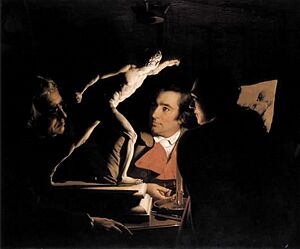Borghese Gladiator facts for kids
Quick facts for kids Borghese Gladiator |
|
|---|---|
| Artist | Agasias of Ephesus (signature) |
| Year | c.100 BC |
| Type | Marble |
| Dimensions | 199 cm (78 in) |
| Location | Musée du Louvre, Paris |

The Borghese Gladiator is a famous marble statue. It's life-size and shows a warrior ready for battle. This ancient sculpture was made around 100 BC in Ephesus. Today, you can see it at the Louvre museum in Paris.
Contents
About the Borghese Gladiator
This amazing statue is called the Borghese Gladiator. It's made of marble and is as tall as a person. The sculpture shows a strong warrior, not a gladiator as its name suggests. He looks like he's fighting someone on horseback.
Who Made This Sculpture?
The artist who made this statue signed his name on its base. His name was Agasias, and his father was Dositheus. We don't know much else about Agasias. He might have been related to another artist named Agasias, son of Menophilus.
Where Was It Found?
The statue was discovered before 1611. It was found near Anzio, a town south of Rome. The ruins were part of an old seaside palace. This palace belonged to the Roman Emperor Nero.
When it was found, people thought it showed a gladiator. But experts later realized it was a warrior. He seems to be fighting a mounted enemy. Some even thought it might be the Greek hero Achilles. They believed he was fighting the Amazon queen, Penthesilea.
How It Became Famous
The Borghese Gladiator became part of the Borghese Collection in Rome. It was kept in a special room at the Villa Borghese. This room was even named after the statue.
In 1807, Napoleon Bonaparte bought the statue. He pressured Camillo Borghese to sell it. The statue was then moved to Paris. It became a star piece at the Louvre museum, where it is now.
Why Is It So Important?
Even though it was misnamed, the Borghese Gladiator was very popular. Many artists in the 1700s admired it. Sculptors used it as a guide for perfect body shapes.
Many copies of the statue were made. A bronze copy was made for Charles I of England. You can still see it at Windsor Castle. Another copy is at Houghton Hall in Norfolk, England. Other copies are found at Petworth House and Knole House. Even Thomas Jefferson wanted a copy for his home, Monticello, in the United States.
The Gladiator in Art
This famous statue has inspired many painters. Artists often used its pose in their own works.
- The artist Peter Paul Rubens saw the statue in Italy. He used a similar pose for a figure in his painting, Conclusion of the Peace at Angers. This painting is also at the Louvre.
- In Watson and the Shark by John Singleton Copley, a figure in the water uses the same pose.
- François-Guillaume Ménageot included the statue in his painting, The Death of Leonardo da Vinci in the arms of Francis I. However, this was a mistake. Leonardo died long before the statue was found.
- The warriors in Thomas Chambers's painting, Two of the Natives of New Holland, Advancing to Combat, also show a similar stance.
- A headless statue in Thomas Cole's painting Destruction is based on the Borghese warrior. This painting is part of his The Course of Empire series.
- The pose of Phineas in Luca Giordano's painting Perseus turning Phineas and his Followers to Stone also looks like the Borghese Gladiator.

